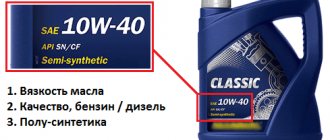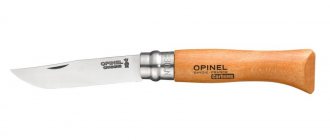I am an engineer by profession, but I have been interested in motor vehicles for many years now and have an almost top-level understanding of all areas of the automotive topic. Today I decided to look into the issue of oil, since many drivers ask and want to know whether it is possible to mix different (in this case we are talking about 5W30 and 5W40 lubricants) types of oils for car operation and how much this will affect the engine.
I have extensive experience working with engines and have used many oils in my practice, so I tried to thoroughly understand this issue. I hope the text below can help both novice car enthusiasts and provide answers to some of their questions even for experienced Kuzmichas, and will also help to avoid mistakes during car repairs.
In addition, you will be able to learn a lot from other people's experiences and gain effective advice for yourself.
Mixing different oils
When carrying out mechanical maintenance of a car, many even experienced car owners asked: is it possible to mix motor lubricants with different markings?
Even the opinions of abstruse experts differ on this issue, some of them say that mixing mixtures is dangerous for the health of the engine and generally reduces its service life, while others are completely sure that it is impossible to establish 100 percent the fault of the mixed oil in the operation of the car and in general mixing cannot lead to any consequences.
We will try to understand on our own whether it is possible to mix 5W30 and 5W40 automobile oils, and we will also find out what this can lead to.
- The need to pour new oil into old oil (meaning oils of different types) or to mix oils of different types appears when there is a certain amount of unused lubricant. Nobody wants to throw away old lubricant, which is why car enthusiasts save the oil for filling another time and try to save money in this way.
- There are also situations when engine lubricant is urgently needed and the driver does not have the required amount of the composition here and now. What to do in this case?
Seasonal viscosity
Classification according to the Society of Automobile Engineers system does not characterize the quality properties of motor oils and is not a recommendation for the use of lubricants in specific brands of cars or certain types of engines. However, thanks to the emergence of such a classification, motor oils began to be divided into summer and winter.
It will also be interesting: Operating principle and testing of the Hall sensor in a car
The first category includes products with a high viscosity index. Summer oils can perform their function normally only if the external temperature exceeds 0 degrees. They form a thick film on the engine parts, protecting them from wear during movement. According to the SAE system, they are assigned an index from 20 to 60W.
Lubricant products, called winter lubricants, have a low viscosity index. On the one hand, such a lubricant does not prevent the engine from starting in extreme cold. But the film it forms does not so reliably protect mechanisms from friction. They are marked from 0W or 5W to 25W
Lubricants for racing cars are included in a separate category. Its main features are a high viscosity index (5W50, 10W60, 15W50, 20W50) and an increased proportion of anti-wear additives containing zinc and phosphorus. If in a standard motor oil their amount is 500-800 ppm, then in an extremely loaded sports oil it increases to 1500-3000 ppm. It is not recommended to use such products for ordinary cars. This will significantly reduce the life of the exhaust system and increase the risk of breakdowns.
So-called all-season lubricants are in particular demand among car enthusiasts. They do not need to be changed with the onset of cold or warm seasons. The viscosity level of such products varies, ensuring long-term operation of power parts. Universal oils have a double viscosity index (0W20, 5w30, 5w40).
To choose the right all-season lubricant, you need to focus on the degree of wear of the car engine. If the total mileage of the car is no more than half of the installed resource, it is recommended to use oil marked 5W30 or 0W20. For a significantly worn engine, a lubricant designated 5W40 is suitable.
How do 5W30/5W40 oils differ from each other?
At first glance, it may seem to you that the differences are only in the designation on the bottle and labeling; it seems as if one number does not solve anything, especially if you drive a car in the summer. In fact, what difference does it make what oil you use in hot weather if the numbers indicate the level of non-freezing of the mixture?
But the numbers still do not guarantee stable operation with mixed lubricant, because there are also individual differences that can also significantly affect the stability of the motor.
- According to the CAE standard adopted in Europe and the USA, this designation 5W30/5W40 shows the differences between positive temperatures, under which the oil retains properties suitable for operation. For a 5W30 type mixture, the highest operating temperature in the engine should not be more than 30 degrees, and for 5W40 oil, this temperature should not exceed 35 degrees.
- This parameter of the thermal stability of the lubricant can be explained as follows - engine oils have different viscosity values. Oil type 5W30 has a much more unstable and fluid structure, which guarantees the best distribution of the product under various conditions.
- The 5W40 series oil is more characterized by a consistency that is stable in viscosity, which is required for better preservation of oil characteristics with a large increase in temperature or humidity. Also, this oil does not provoke the appearance of crystallization of the product at low temperatures.
- The properties of the oil are also affected by the manufacturer and its composition. A huge number of oil refining companies in the world produce oils for cars, so it would be quite absurd to think that these lubricants are complete copies of each other. Even if you take one company, the 5W30 and 5W40 lubricants created by it are very different in their structure.
The differences also include the chemical base of the oils and tolerances. These lubricants can be sold in the form of various chemical substances (in the form of mineral water, semi-synthetic or have a synthetic base), so the tolerances are also the same.
Having learned all this, I personally immediately stopped wanting to mix these types of liquids in one engine - since they differ quite significantly in almost all parameters. Accordingly, I do not recommend doing this unless you want to ruin your motor or significantly reduce its service life.
Selection rules
Every motorist knows that motor oil must be of high quality. But how to choose a really good product remains a mystery to many. When choosing, you should follow a few simple rules.
You need to pay attention to whether the oil is approved by the car manufacturer or not. Unfortunately, not all products of domestic and foreign companies have recommendations for use from large automakers.
For an oil to be approved for use, it must pass several tests. There is no doubt about the quality of products that have undergone this procedure. The label of such oil indicates the make of the car and a special index. By comparing it with the data specified in the technical documentation for the car, you can find out exactly whether it is suitable for a particular car.
The next noteworthy point is the composition. High-quality oil should contain:
- oil base (75−85%);
- additive package (10−20%);
- viscosity modifier (5−10%).
It must contain substances that slow down the rate of chemical processes - inhibitors. The share of such substances in the total volume should not exceed 1%.
To determine the properties of motor oil, you need to properly understand its classification. For Japanese, American and European-made machines, API, ACEA and ILSAC standards are generally accepted.
The most widely used classification was created by the American Fuels Institute in 1969. According to the API, oils are usually divided into four types: for gasoline engines, diesel engines, two-stroke devices and transmissions.
The marking of oil products for gasoline engines is a combination of two Latin letters. The first is the letter S. The second can be anything, but the closer it is to the beginning of the alphabet, the better. The SN marking is considered the most optimal.
Diesel oils are marked according to the same principle, but the letter C is indicated first in the designation (for example, CJ). If the label contains the double inscription type SN/CF, then this product is suitable for diesel and gasoline engines.
If the oil container does not indicate which quality standard it meets, this indicates that it is not certified, or the class to which it is assigned is outdated and no longer used.
It will also be interesting: List of the best and best-selling minivans in Russia in 2021
Interaction between oils of the 5W30 and 5W40 series
Keep in mind that in one vehicle power plant it is possible to mix only those motor lubricants that have a certain similarity. For example, oils were produced by one manufacturer and have the same chemical. base. In this case, the oil creates a homogeneous structure that can act freely in the power unit without any particular consequences for the operation of the machine. But the problem is that, as mentioned earlier, manufacturers create completely different oils and mixing one with the other is strictly not recommended.
Comparison of synthetic base and mineral
In this matter, I can only advise one thing - try it and try to learn from your own experience, but I wouldn’t count on a good result if I were you. By itself, mineral water from any manufacturer does not have good viscosity and loses it under long-term loads or with large temperature jumps down or up. Therefore, various additives are usually added to the mixture to improve the physical properties of the oil.
This is how unstable motor oil is formed in the car, which evaporates under the influence of maximum temperature. European chemists advise drivers to mix synthetic and regular oil only when absolutely necessary. But it’s still better not to do this.
When we combine oils of the 5W30 and 5W40 series, we get a mixture labeled 5W3X, in which the X value is essentially an indicator that depends on the volume of the first/second oil. This composition can only be used in a car for a few days: then the oil will quickly lose its performance properties and become like some kind of mass with an incomprehensible color.
Automotive companies try to accurately establish and give instructions which mixtures should be used for filling the engine, and which ones are not recommended to be used.
If a day ago you filled your car with 5W40 series lubricant, and now you decide to add 5W30 series oil there, then the previous viscosity indicator will be forever lost and the weak viscosity of the lubricant will not be able to retain the lubricant on metal surfaces.
SAE classification system
The main components that make up a car oil determine its quality characteristics. One of these characteristics is viscosity. This term is commonly used to refer to the ability of oil fluid to remain on the surface of engine parts and maintain good fluidity. Viscosity is a variable indicator that directly depends on the engine temperature.
At low temperatures, the viscosity should remain low in order to maintain the possibility of a cold engine start and not disrupt the process of pumping lubricant through the system. At high temperatures, the viscosity value must be sufficient to maintain optimal pressure inside the system and create a thin lubricating film between parts subject to friction during movement.
The American Association of Automotive Engineers (SAE) has created a system that classifies the properties of motor oils at different temperatures. The classification is based on the following parameters:
- Starting properties. They affect the resistance when starting a cold engine and the ability to achieve starting speed. They are determined at negative temperatures in the range from -10 to -35 degrees and low shear rates (from 20 to 100 s-1).
- Pumpability. It shows the speed at which lubricant reaches the friction pairs during a cold start and determines the likelihood of engine failure due to rotation of the bearings. Installed at temperatures from -15 to -40 degrees C and a shear rate of about 10 s-1. During the pumpability assessment, the conditions for the passage of oil in the pan to the oil receiver and in the oil receiver of the pump are realized in the event of a cold start.
- Viscosity at high temperature. Demonstrates the real viscosity of the product during the summer operation of modern highly loaded engines. Determines the anti-wear qualities of the lubricant, friction losses and the impact on engine efficiency. Determined at a temperature of 150 degrees and high shear rates (about 106 s-1). This creates conditions for simulating the load on the crankshaft bearings.
- Another important characteristic is kinematic viscosity. It determines which class the oil will be classified into. Determined at 100 degrees.
What can mixing these lubricants lead to?
If you are a fan of experimenting with your car and you don’t care how the power plant works, then experts warn about the consequences of mixing oils.
As we have learned, motor lubricants with almost identical compositions and tolerances can be mixed with each other and driven on this mixture for several days, without impairing the usual performance of the engine compartment.
In addition to oil starvation, there is a huge likelihood of aggressive chemicals appearing. reactions due to incompatible additives. Their production technology is usually kept secret by manufacturing companies.
When should you mix 5W30 and 5W40 series oils?
When studying the instructions for your car regarding the engine (you can find it in the car manual), you should pay attention to those types of oils that are prohibited for use. If among these oils there is at least one of the lubricants discussed above, then there can be no talk of any miscibility.
Such seemingly safe actions with your car at first glance can provoke quite tangible consequences, but still, the likelihood of their occurrence is at a low level. Therefore, it is recommended to add oils of different series to each other only as a last resort.
For example, if you are going on a trip and suddenly realize that the lubricant level is at a low level, while the store is still quite far away, then you can fill in almost any mixture that comes to hand. The main thing here is that you don’t forget to drain this mess in the near future.










